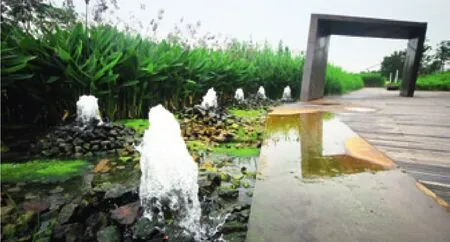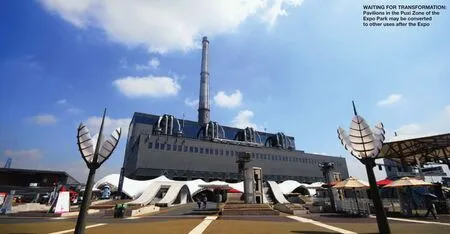The Curtain Falls
2010-10-14
The Curtain Falls

Once an even t is finished, all big international event organizers have a headache trying to figure out what to do w ith old facilities and venues, such as stadiums, pavilions and the like. High maintenance costs usually pose severe financial burdens for host cities. W ill the 5.28-square-km Shanghai Expo site face a sim ilar problem?Expo Weeklytalked to W u Zh iqiang, Chief Planner of the Shanghai World Expo and Dean of the College of Architecture and Planning at Shanghai’s Tongji University.
Expo Weekly: W hat do you think are successfu l exam p les of post-Expo facility use?
Wu Zhiqiang: The Expo sites in Spain,Germany and Portugal were changed into science and technology parks and national exhibition centers after the Expo, which are successful examples we should learn from.I believe the Shanghai Expo site will also be a successful case. As early as its planning stage, the Shanghai World Expo took into consideration the city’s future, the future of all Chinese cities and successful global cases of urbanization. The theme Better City,Better Life made us aware of the importance of planning for the future of the site at an early stage.
The Expo Axis, the China Pavilion,the Them e Pavilion, the Expo Cu lture Center and the Expo Center w ill be retained after the Expo. How w ill they be used in the future?
If we had left this question to the present moment to answer, it would already be too late. I have visited many past Expo venues and few of them could be called successful.Shanghai’s Expo site has already planned its utilization for the next two decades. In this sense, it is an unprecedented breakthrough for the history of the Expo.
The Gourmet Plaza located betw een the Expo Center and the Theme Pavilion is the appointed location for a hotel which w ill serve as part of Asia’s biggest international exhibition center in the future together w ith the Expo Center, the Theme Pavilion and the China Pavilion. In my view, the most prom ising planning must be sustainable. We have learned a municipality like Shanghai must possess a total exhibition area of 600,000 square meters.Now we only have 400,000 square meters;but the Expo site-turned-exhibition center in the future w ill make up for the m issing 200,000 square meters. It is true to say that the Expo Axis and the four pavilions around it were built for the Expo, but they also were intended to serve Shanghai’s needs as a major exhibition city.
W hat w ill be the other highlights of the Expo site after the Expo?
A ll the roads today in the Expo site w ill be urban roads and no road w ill be torn up.The Expo Culture Center w ill be a perfect venue to hold great international shows and the Expo Center w ill be an international convention center. Shanghai does not have a museum of Chinese history and the China Pavilion w ill play that role.
We have seen this place serve beautifully as an Expo site; in the future, it w ill surprise us by becom ing a new center of the city.Some day we w ill find that Shanghai w ill become more beautiful as a result of successful utilization of the Expo site. How amazing that will be!
The Expo has m any wonder fu l pavilions that have fascinated visitors from around the world. Some say they should be kep t after the Expo. W hat is you r view?
W e have had a thorough discussion about whether pavilions should be kept or not. The answer is no. Historically speaking, some pavilions have remained after the Expo, but they were finally demolished several years later because they were not designed to be permanent.
The Bureau of International Expositions says the 42 national pavilions designed and built by countries themselves are temporary buildings and must be demolished after the Expo. We have to observe the rules.
Everyone who has been involved in the Expo must have a soft spot for those pavilions. They are like our children and are the fruits of years of hard work. Emotionally speaking, we do not want to see them pulled down.
W hat w ill happen to the space after the pavilions are removed?
The removal cannot be finished in one day. The demolition w ill be a long process.If the construction of pavilions is a part of the Expo, why not the demolition? In fact, I would rather give the demolition a new name—transformation. In the past we transformed the Jiangnan Shipyard into Expo pavilions. So why can’t we transform pavilions into museums in the future? In m y view, good transformation is more important than good construction. The Chinese people are w ise enough to deal w ith this problem.
W hat about the Puxi (west of the Huangpu River) side of the Expo site?W ill the disp lays continue?
The Urban Best Practices Area (UBPA)and corporate pavilions on the Puxi side display some of the most advanced and modern ideas in urban planning and other fields, w hich w ill be essential to urban development in the future. The success of today’s Shanghai can be traced back to industrialization and modernization more than 100 years ago. Today’s display in the UBPA and corporate pavilions m ight enlighten some cities or enterprises. So why not change corporate pavilions into the mu-seums of various businesses? Why could the area not become a platform for China’s major businesses in the future? Someday the most advanced ideas m ight develop here.
For creative industries, the w orkshop is always more important than a mere product disp lay. As w e all know,the process of painting interests visitors much more than the final work itself.The UBPA allows us to study how cities evolve and grow, rather than how the city looks today.
W hat w ill Puxi become in the future?
Puxi made glorious achievements in industrialization early last century.China’s first cannon and airplane were produced in Puxi. In the future, Puxi will play a leading ro le in p rom oting new practices in urban development and the newest technology and trends w ill be dissem inated there.
For average Shanghai residents, what are most im portant legacies of the Expo?

GREEN MEMORY: Houtan Park w ill be one o f the legac ies o f the Expo
The huge green land along the Huangpu River will be the biggest legacy for common people. Lovers, children and senior citizens will be able to relax there.This April, Isaw a migrant worker couple play w ith water in Houtan Park. You know, the water there used to be polluted and the Expo has changed that. Greatly improved public transportation w ill be another legacy.

WAITING FOR TRANSFORMATION:Pavilions in the Puxi Zone of the Expo Park m ay be converted to other uses after the Expo
